Interannual Variability of Energy and CO2 Exchanges in a Remnant Area of the Caatinga Biome under Extreme Rainfall Conditions
Abstract
1. Introduction
2. Materials and Methods
2.1. Study Area
2.2. Micrometeorological Measurements and Application of the SITE (Simple Tropical Ecosystem) Model
3. Results and Discussion
Rainfall, Temperature and Radiation
4. Energy Balance
CO2 Balance
5. Conclusions
Author Contributions
Funding
Institutional Review Board Statement
Informed Consent Statement
Data Availability Statement
Acknowledgments
Conflicts of Interest
References
- Le Quéré, C.; Peters, G.P.; Andres, R.J.; Andrew, R.M.; Boden, T.A.; Ciais, P.; Friedlingstein, P.; Houghton, R.A.; Marland, G.; Moriarty, R.; et al. Global carbon budget 2013. Earth Syst. Sci. Data 2014, 6, 235–263. [Google Scholar] [CrossRef]
- Ahlström, A.; Raupach, M.R.; Schurgers, G.; Smith, B.; Arneth, A.; Jung, M.; Reichstein, M.; Canadell, J.G.; Friedlingstein, P.; Jain, A.K.; et al. The dominant role of semi-arid ecosystems in the trend and variability of the land CO2 sink. Science 2015, 348, 895–899. [Google Scholar] [CrossRef]
- Araujo, K.D.; Dantas, R.T.; Andrade, A.P.D.; Parente, H.N. Cinética de Evolução de Dióxido de Carbono em Área de Caatinga em São João do Cariri-PB. Rev. Arvore 2011, 35, 1099–1106. [Google Scholar] [CrossRef]
- Costa, G.B.; Mendes, K.R.; Viana, L.B.; Almeida, G.V.; Mutti, P.R.; Silva, C.M.S.e.; Bezerra, B.G.; Marques, T.V.; Ferreira, R.R.; Oliveira, C.P.; et al. Seasonal Ecosystem Productivity in a Seasonally Dry Tropical Forest (Caatinga) Using Flux Tower Measurements and Remote Sensing Data. Remote Sens. 2022, 14, 3955. [Google Scholar] [CrossRef]
- Marengo, J.A.; Souza, C.M.; Thonicke, K.; Burton, C.; Halladay, K.; Betts, R.A.; Alves, L.M.; Soares, W.R. Changes in Climate and Land Use Over the Amazon Region: Current and Future Variability and Trends. Front. Earth Sci. 2018, 6, 228. [Google Scholar] [CrossRef]
- Le Quéré, C.; Raupach, M.R.; Canadell, J.G.; Marland, G.; Bopp, L.; Ciais, P.; Conway, T.J.; Doney, S.C.; Feely, R.A.; Foster, P.; et al. Trends in the sources and sinks of carbon dioxide. Nat. Geosci. 2009, 2, 831–836. [Google Scholar] [CrossRef]
- Masson-Delmotte, V.; Zhai, P.; Pirani, A.; Connors, S.L.; Péan, C.; Chen, Y.; Berger, S.; Huang, M.; Yelekçi, O.; Yu, R.; et al. Climate change 2021: The physical science basis. In Contribution of Working Group I to the Sixth Assessment Report of the Intergovernmental Panel on Climate Change; IPCC: Geneva, Switzerland, 2021. [Google Scholar]
- Araújo, A.C.; Nobre, A.D.; Kruijt, B.; Elbers, J.A.; Dallarosa, R.; Stefani, P.; Randow, C.; von Manzi, A.O.; Culf, A.D.; Gash, J.H.C.; et al. Comparative measurements of carbon dioxide fluxes from two nearby towers in a centralAmazonian rainforest: The Manaus LBA site. J. Geophys. Res. 2002, 107, 8090. [Google Scholar] [CrossRef]
- Malhi, Y.; Aragão, L.E.O.C.; Metcalfe, D.B.; Paiva, R.; Quesada, C.A.; Almeida, S.; Anderson, L.; Brando, P.; Chambers, J.Q.; Costa, A.C.L.; et al. Comprehensive assessment of carbon productivity, allocation and storage in three Amazonian forests. Glob. Chang. Biol. 2009, 15, 1255–1274. [Google Scholar] [CrossRef]
- Campos, S.; Mendes, K.R.; da Silva, L.L.; Mutti, P.R.; Medeiros, S.S.; Amorim, L.B.; Santos, C.A.; Perez-Marin, A.M.; Ramos, T.M.; Marques, T.V.; et al. Closure and partitioning of the energy balance in a preserved area of a Brazilian seasonally dry tropical forest. Agric. For. Meteorol. 2019, 271, 398–412. [Google Scholar] [CrossRef]
- Feng, X.; Porporato, A.; Rodriguez-Iturbe, I. Changes in rainfall seasonality in the tropics. Nat. Clim. Change 2013, 3, 811. [Google Scholar] [CrossRef]
- Chadwick, R.; Good, P.; Martin, G.; Rowell, D.P. Large rainfall changes consistently projected over substantial areas of tropical land Nat. Clim. Change 2016, 6, 177. [Google Scholar]
- Brito, S.S.B.; Cunha, A.P.M.A.; Cunningham, C.C.; Alvalá, R.C.; Marengo, J.A.; Carvalho, M.A. Frequency, duration and severity of drought in the Semiarid Northeast Brazil region. Int. J. Climatol. 2018, 38, 517–529. [Google Scholar] [CrossRef]
- Fernández-Martínez, M.; Vicca, S.; Janssens, I.A.; Luyssaert, S.; Campioli, M.; Sardans, J.; Estiarte, M.; Peñuelas, J. Spatial variability and controls over biomass stocks, carbon fluxes, and resource-use efficiencies across forest ecosystems. Trees 2014, 28, 597–611. [Google Scholar] [CrossRef]
- Koch, R.; Almeida-Cortez, J.S.; Kleinschmit, B. Revealing areas of high nature conservation importance in a seasonally dry tropical forest in Brazil: Combination of modelled plant diversity hot spots and threat patterns. J. Nat. Conserv. 2017, 35, 24–39. [Google Scholar] [CrossRef]
- Särkinen, T.; Iganci, J.R.; Linares-Palomino, R.; Simon, M.F.; E Prado, D. Forgotten forests—Issues and prospects in biome mapping using Seasonally Dry Tropical Forests as a case study. BMC Ecol. 2011, 11, 27. [Google Scholar] [CrossRef]
- Dombroski, J.L.D.; Praxedes, S.; de Freitas, R.; Pontes, F. Water relations of Caatinga trees in the dry season. S. Afr. J. Bot. 2011, 77, 430–434. [Google Scholar] [CrossRef]
- Mutti, P.R.; da Silva, L.L.; Medeiros, S.D.S.; Dubreuil, V.; Mendes, K.R.; Marques, T.V.; Lúcio, P.S.; Silva, C.M.S.; Bezerra, B.G. Basin scale rainfall-evapotranspiration dynamics in a tropical semiarid environment during dry and wet years. Int. J. Appl. Earth Obs. Geoinform. 2019, 75, 29–43. [Google Scholar] [CrossRef]
- Silva, P.F.; de Sousa Lima, J.R.; Antonino, A.C.D.; Souza, R.; de Souza, E.S.; Silva, J.R.I.; Alves, E.M. Seasonal patterns of carbon dioxide, water and energy fluxes over the Caatinga and grassland in the semi-arid region of Brazil. J. Arid. Environ. 2017, 147, 71–82. [Google Scholar] [CrossRef]
- Marques, T.V.; Mendes, K.; Mutti, P.; Medeiros, S.; Silva, L.; Perez-Marin, A.M.; Campos, S.; Lúcio, P.S.; Lima, K.; dos Reis, J.; et al. Environmental and biophysical controls of evapotranspiration from Seasonally Dry Tropical Forests (Caatinga) in the Brazilian Semiarid. Agric. For. Meteorol. 2020, 287, 107957. [Google Scholar] [CrossRef]
- Mendes, K.R.; Campos, S.; da Silva, L.L.; Mutti, P.R.; Ferreira, R.R.; Medeiros, S.S.; Perez-Marin, A.M.; Marques, T.V.; Ramos, T.M.; Vieira, M.M.D.L.; et al. Seasonal variation in net ecosystem CO2 exchange of a Brazilian seasonally dry tropical forest. Sci. Rep. 2020, 10, 9454. [Google Scholar] [CrossRef]
- Borges, C.K.; Dos Santos, C.A.C.; Carneiro, R.G.; Da Silva, L.L.; De Oliveira, G.; Mariano, D.; Silva, M.T.; Da Silva, B.B.; Bezerra, B.G.; Perez-Marin, A.M.; et al. Seasonal variation of surface radiation and energy balances over two contrasting areas of the seasonally dry tropical forest (Caatinga) in the Brazilian semi-arid. Environ. Monit. Assess. 2020, 192, 524. [Google Scholar] [CrossRef]
- Silva, A.C.; Rêgo Mendes, K.; Santos E Silva, C.M.; Torres Rodrigues, D.; Brito Costa, G.; Thainara Corrêa Da Silva, D.; Rodrigues Mutti, P.; Rodrigues Ferreira, R.; Guedes Bezerra, B. Energy Balance, CO2 Balance, and Meteorological Aspects of Desertification Hotspots in Northeast Brazil. Water 2021, 13, 2962. [Google Scholar] [CrossRef]
- Mu, Q.; Zhao, M.; Running, S.W. Improvements to a MODIS global terrestrial evapotranspiration algorithm. Remote Sens. Environ. 2011, 115, 1781–1800. [Google Scholar] [CrossRef]
- Huang, S.; Li, H.; Wang, M.; Qian, Y.; Steenland, K.; Caudle, W.M.; Liu, Y.; Sarnat, J.; Papatheodorou, S.; Shi, L. Long-term exposure to nitrogen dioxide and mortality: A systematic review and meta-analysis. Sci. Total Environ. 2021, 776, 145968. [Google Scholar] [CrossRef]
- Cunha, A.P.M.A.; Alvalá, R.C.; Sampaio, G.; Shimizu, M.H.; Costa, M.H. Calibration and Validation of the Integrated Biosphere Simulator (IBIS) for a Brazilian Semiarid Region. J. Appl. Meteorol. Climatol. 2013, 52, 2753–2770. [Google Scholar] [CrossRef]
- Jaeger, E.B.; Stöckli, R.; Seneviratne, S.I. Analysis of planetary boundary layer fluxes and land–atmosphere coupling in the regional climate model CLM. J. Geophys. Res. 2009, 114, D17106. [Google Scholar] [CrossRef]
- Pilotto, I.L.; Rodríguez, D.A.; Tomasella, J.; Sampaio, G.; Chou, S.C. Comparisons of the Noah-MP land surface model simulations with measurements of forest and crop sites in Amazonia. Meteorol. Atmos. Phys. 2015, 127, 711–723. [Google Scholar] [CrossRef]
- Manoli, G.; Ivanov, V.Y.; Fatichi, S. Dry-Season Greening andWater Stress in Amazonia: The Role of Modeling Leaf Phenology. J. Geophys. Res. Biogeosci. 2018, 123, 1909–1926. [Google Scholar] [CrossRef]
- Oliveira, M.L.; dos Santos, C.A.C.; Santos, F.A.C.; de Oliveira, G.; Santos, C.A.G.; Bezerra, U.A.; de B. L. Cunha, J.E.; da Silva, R.M. Evaluation of Water and Carbon Estimation Models in the Caatinga Biome Based on Remote Sensing. Forests 2023, 14, 828. [Google Scholar] [CrossRef]
- Andrade, N.L.R.D.; Aguiar, R.G.; Sanches, L.; Alves, É.C.R.D.F.; Nogueira, J.D.S. Partição do saldo de radiação em áreas de floresta amazônica e floresta de transição Amazônia—Cerrado. Rev. Bras. Meteorol. 2009, 24, 346–355. [Google Scholar] [CrossRef]
- Mendes, K.R.; Campos, S.; Mutti, P.R.; Ferreira, R.R.; Ramos, T.M.; Marques, T.V.; dos Reis, J.S.; Vieira, M.M.d.L.; Silva, A.C.N.; Marques, A.M.S.; et al. Assessment of site for CO2 and energy fluxes simulations in a seasonally dry tropical forest (Caatinga ecosystem). Forests 2021, 12, 86. [Google Scholar] [CrossRef]
- Vilani, M.T.; Pinheiro, M.; Alves, L.S.; de Andrade, N.L.R.; de Carvalho Alves, M.; de Souza Nogueira, J. Modelling net ecosystem CO2 exchange by simple tropical ecosystem model. J. Converg. Inf. Technol. 2010, 5, 11. [Google Scholar]
- Sanches, L.; de Andrade, N.L.R.; Costa, M.H.; Alves, M.d.C.; Gaio, D. Performance evaluation of the SITE model to estimate energy flux in a tropical semi-deciduous forest of the southern Amazon Basin. Int. J. Biometeorol. 2011, 55, 303–312. [Google Scholar] [CrossRef]
- Santos, S.N.M.; Costa, M.H. A simple tropical ecosystem modelo f carbon, water and energy fluxes. Ecol. Model. 2004, 176, 291–312. [Google Scholar] [CrossRef]
- Costa, C.A.G.; Lopes, J.W.B.; Pinheiro, E.A.R.; Araújo, J.C.; Gomes-Filho, R.R. Spatial behaviour of soil moisture in the root zone of the Caatinga biome. Rev. Ciência Agronômica 2013, 44, 685–694. [Google Scholar] [CrossRef]
- Queiroz, L.P.; Cardoso, D.; Fernandes, M.F.; Moro, M.F. Diversity and Evolution of Flowering Plants of the Caatinga Domain. In Caatinga: The Largest Tropical Dry Forest Region in South America; Da Silva, J.M.C., Leal, I.R., Tabarelli, M., Eds.; Springer: Cham, Switzerland, 2017; pp. 23–63. [Google Scholar]
- Jensen, R.; Herbst, M.; Fribog, T. Direct and indirect controls of the interanual variability in atmospheric CO2 exchange of three contrasting ecosystems in Denmark. Agric. For. Meteorol. 2017, 233, 12–31. [Google Scholar] [CrossRef]
- Bezerra, B.G.; e Silva, C.M.S.; Mendes, K.R.; Mutti, P.R.; Fernandes, L.S.; Marques, T.V.; Silva, C.L.C.; Campos, S.; de Lima Vieira, M.M.; Urbano, S.A.; et al. CO2 exchanges and evapotranspiration of a grazed pasture under tropical climate conditions. Agric. For. Meteorol. 2022, 323, 109088. [Google Scholar] [CrossRef]
- Reichstein, M.; Falge, E.; Baldocchi, D.; Papale, D.; Aubinet, M.; Berbigier, P.; Bernhofer, C.; Buchmann, N.; Gilmanov, T.; Granier, A.; et al. On the separation of net ecosystem exchange into assimilation and ecosystem respiration: Review and improved algorithm. Glob. Change Biol. 2005, 11, 1424–1439. [Google Scholar] [CrossRef]
- Lloyd, J.; Taylor, J.A. On the Temperature Dependence of Soil Respiration. Funct. Ecol. 1994, 8, 315–323. [Google Scholar] [CrossRef]
- Costa, M.H.; Nunes, E.L.; Senna, M.C.A.; Imbuzeiro, H.M.A. Estado-da-arte da simulação da taxa de fixação de carbono de ecossistemas tropicais. Rev. Bras. Meteorol. 2009, 24, 179–187. [Google Scholar] [CrossRef]
- Santos, M.G.; Oliveira, M.T.; Figueiredo, K.V.; Falcao, H.M.; Arruda, E.C.; Almeida-Cortez, J.; Sampaio, E.V.S.B.; Ometto, J.P.H.B.; Menezes, R.S.C.; Oliveira, A.F.M.; et al. Caatinga, the Brazilian dry tropical forest: Can it tolerate climate changes? Theor. Exp. Plant. Physiol. 2014, 26, 83–99. [Google Scholar] [CrossRef]
- Lima-Silva, P.S.L.; Cunha, T.M.S.; Souza, A.D.; de Paula, V.F.S. Equations for leaf area estimation in some species adapted to the Brazilian Semi-arid. Rev. Caatinga 2007, 20, 18–23. [Google Scholar]
- Mendes, K.R.; Granja, J.A.; Ometto, J.P.; Antonino, A.C.; Menezes, R.S.; Pereira, E.C.; Pompelli, M.F. Croton blanchetianus modulates its morphophysiological responses to tolerate drought in a tropical dry forest. Funct. Plant Biol. 2017, 10, 1–13. [Google Scholar] [CrossRef]
- Rezende, L.F.C.; Arenque-Musa, B.C.; Moura, M.D.; Aidar, S.D.T.; Von Randow, C.; Menezes, R.S.C.; Ometto, J.P.B.H. Calibration of the maximum carboxylation velocity (Vcmax) using data mining techniques and ecophysiological data from the Brazilian semiarid region, for use in Dynamic Global Vegetation Models. Braz. J. Biol. 2016, 76, 341–351. [Google Scholar] [CrossRef]
- Pagoto, M.A.; Roig, F.A.; Ribeiro, A.S.; Lisi, C.S. Influence of regional rainfall and Atlantic sea surface temperature on tree-ring growth of Poincianella pyramidalis, semiarid forest from Brazil. Dendrochronologia 2015, 35, 14–23. [Google Scholar] [CrossRef]
- R Core Team. R: A Language and Environment for Statistical Computing; R Foundation for Statistical Computing: Vienna, Austria, 2022; Available online: https://www.R-project.org/ (accessed on 1 August 2022).
- Monteiro, F. Correlações entre os ciclos solares e o regime pluviométrico na Região Geográfica Intermediária de Caicó/RN. Master’s Dissertation, Universidade Federal do Rio Grande do Norte, Natal, Brazil, 2020. [Google Scholar]
- Kaminsky, K.Z.; Dubayah, R. Estimation of surface net radiation in the boreal forest and northern prairie from shortwave flux measurements. J. Geophys. Res. Atmos. 1997, 102, 29707–29716. [Google Scholar] [CrossRef]
- Alados, I.; Foyo-Moreno, I.; Olmo, F.; Alados-Arboledas, L. Relationship between net radiation and solar radiation for semi-arid shrub-land. Agric. For. Meteorol. 2003, 116, 221–227. [Google Scholar] [CrossRef]
- Kuricheva, O.A.; Avilov, V.K.; Dinh, D.B.; Sandlersky, R.B.; Kuznetsov, A.N.; Kurbatova, J.A. Seasonality of energy and water fluxes in a tropical moist forest in Vietnam. Agric. For. Meteorol. 2021, 298–299, 108268. [Google Scholar] [CrossRef]
- Jin, Y.; Liu, Y.; Liu, J.; Zhang, X. Energy Balance Closure Problem over a Tropical Seasonal Rainforest in Xishuangbanna, Southwest China: Role of Latent Heat Flux. Water 2022, 14, 395. [Google Scholar] [CrossRef]
- Oliveira, M.B.L.; Santos, A.J.B.; Manzi, A.O.; Alvalá, R.C.d.S.; Correia, M.d.F.; de Moura, M.S.B. Trocas de energia e fluxo de carbono entre a vegetação de Caatinga e a atmosfera no Nordeste Brasileiro. Rev. Bras. Meteorol. 2006, 21, 378–386. [Google Scholar]
- Teixeira, A.H.D.C.; Bastiaanssen, W.G.; Ahmad, M.D.; Moura, M.D.; Bos, M.G. Analysis of energy fluxes and vegetation-atmosphere parameters in irrigated and natural ecosystems of semi-arid Brazil. J. Hydrol. 2008, 362, 110–127. [Google Scholar] [CrossRef]
- Souza, L.S.B.; Moura, M.S.B.; Sediyama, G.C.; Silva, T.G.F. Balanço de energia e controle biofísico da evapotranspiração na Caatinga em condições de seca intensa. Pesqui. Agropecuária Bras. 2015, 50, 627–636. [Google Scholar] [CrossRef]
- Galvão, J.A.D.C.; Fisch, G. Balanço de energia em áreas de floresta e de pastagem na Amazônia. Rev. Bras. Meteorol. 2000, 15, 25–37. [Google Scholar]
- Priante Filho, N.; Hayashi, M.M.S.; De Nogueira, J.S.; Campelo, J.H., Jr.; Nunes, P.C.; Sanches, L.; Couto, E.G.; Hoeger, W.; Raiter, F.; Trienweiler, J.L.; et al. Comparison of the mass and energy exchange of a pasture and a mature transitional tropical forest of the southern Amazon basin during the wet-dry season transition. Glob. Change Biol. 2004, 10, 863–876. [Google Scholar] [CrossRef]
- Schwinning, S.; Sala, O.E. Hierarchy of responses to resource pulses in arid and semi-arid ecosystems. Oecologia 2004, 141, 211–220. [Google Scholar] [CrossRef] [PubMed]
- Wilson, K.; Goldstein, A.; Falge, E.; Aubinet, M.; Baldocchi, D.; Berbigier, P.; Bernhofer, C.; Ceulemans, R.; Dolman, H.; Field, C.; et al. Energy balance closure at FLUXNET sites. Agric. For. Meteor. 2002, 113, 223–243. [Google Scholar] [CrossRef]
- Carvalho, H.F.S. Dinâmica dos fluxos de energia e água na caatinga e cana-de-açúcar irrigada no Semiárido brasileiro. Master’s Dissertation, Universidade Federal do Vale do São Francisco, Juazeiro, BA, Brazil, 2017. [Google Scholar]
- Yu, B.; Liu, G.; Liu, Q.; Wang, X.; Feng, J.; Huang, C. Soil moisture variations at different topographic domains and land use types in the semi-arid Loess Plateau, China. Catena 2018, 165, 125–132. [Google Scholar] [CrossRef]
- Chen, Z.; Yu, G.; Wang, Q. Magnitude, pattern and controls of carbon flux and carbon use efficiency in China’s typical forests. Glob. Planet. Change 2019, 172, 464–473. [Google Scholar] [CrossRef]
- Rocha, H.R.; Freitas, H.C.; Rosolem, R.; Juárez, R.I.; Tannus, R.N.; Ligo, M.A.; Cabral, O.M.R.; Dias, M.A.S. Measurements of CO2 exchange over a woodland savanna (Cerrado Sensu stricto) in southeast Brasil. Biota Neotrop. 2002, 2, 1–11. [Google Scholar] [CrossRef]
- Gitelson, A.A.; Gamon, J.A.; Solovchenko, A. Multiple drivers of seasonal change in PRI: Implications for photosynthesis 2. Stand level. Remote Sens. Environ. 2017, 190, 198–206. [Google Scholar] [CrossRef]
- Dalmolin, A.C.; de Almeida Lobo, F.; Vourlitis, G.; Silva, P.R.; Dalmagro, H.J.; Antunes, M.Z.; Ortíz, C.E.R. Is the dry season an important driver of phenology and growth for two Brazilian savanna tree species with contrasting leaf habits? Plant Ecol. Dordr. 2015, 216, 407–417. [Google Scholar] [CrossRef]
- Moreira, D.S. Simulação numérica do ciclo do carbono na Amazônia. Ph.D. Thesis, Instituto Nacional de Pesquisas Espaciais, São José dos Campos, Brazil, 2013. [Google Scholar]
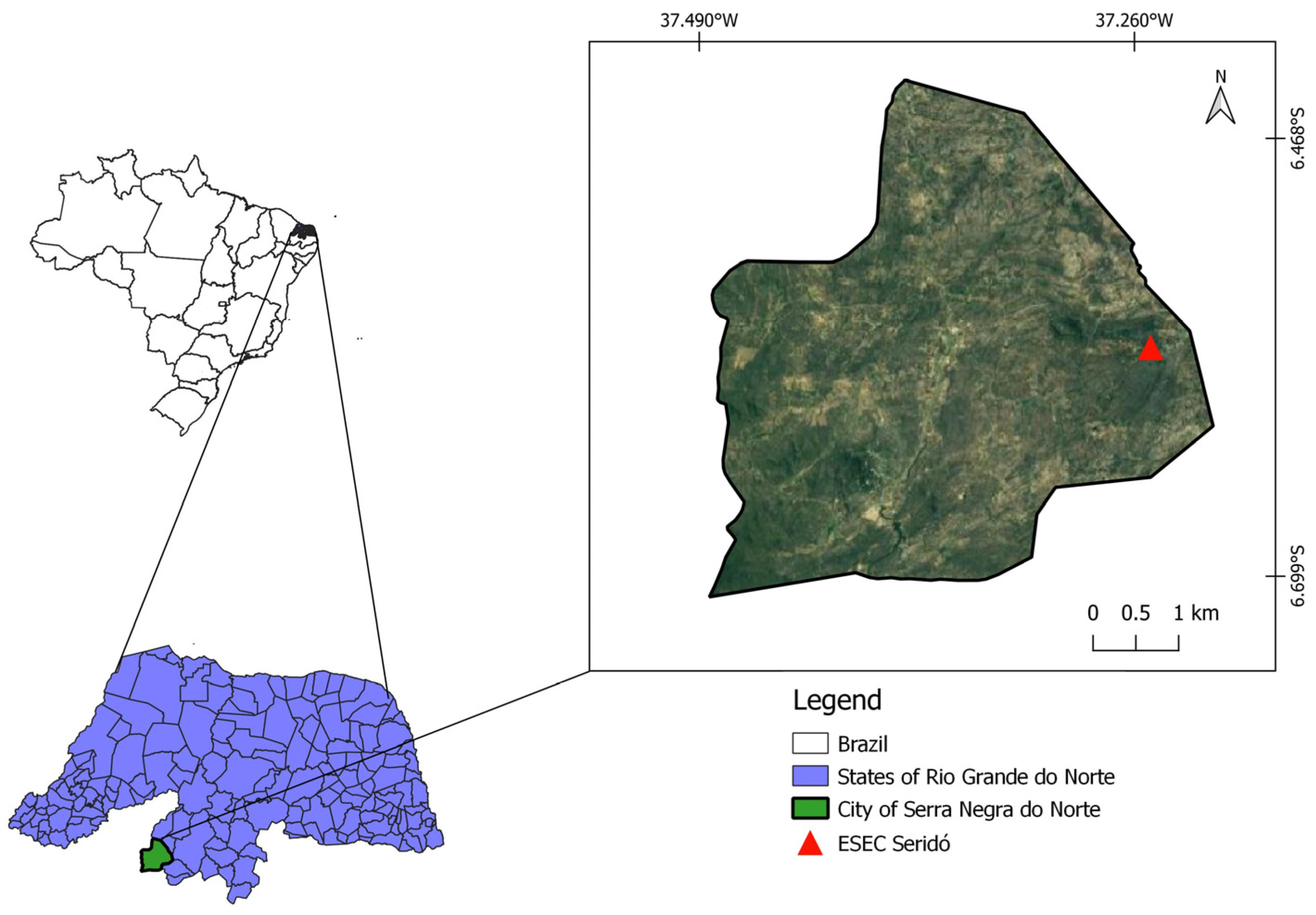
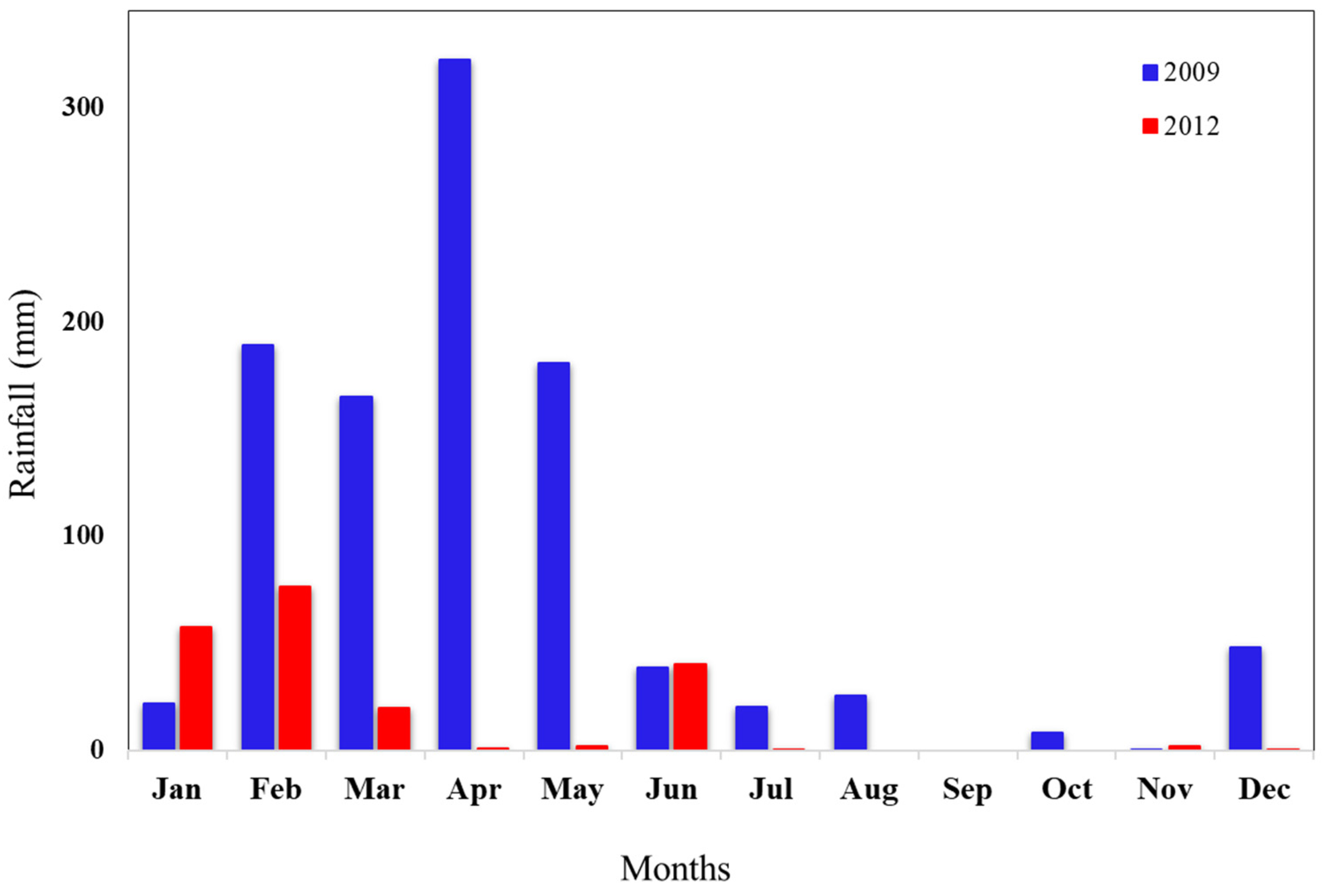
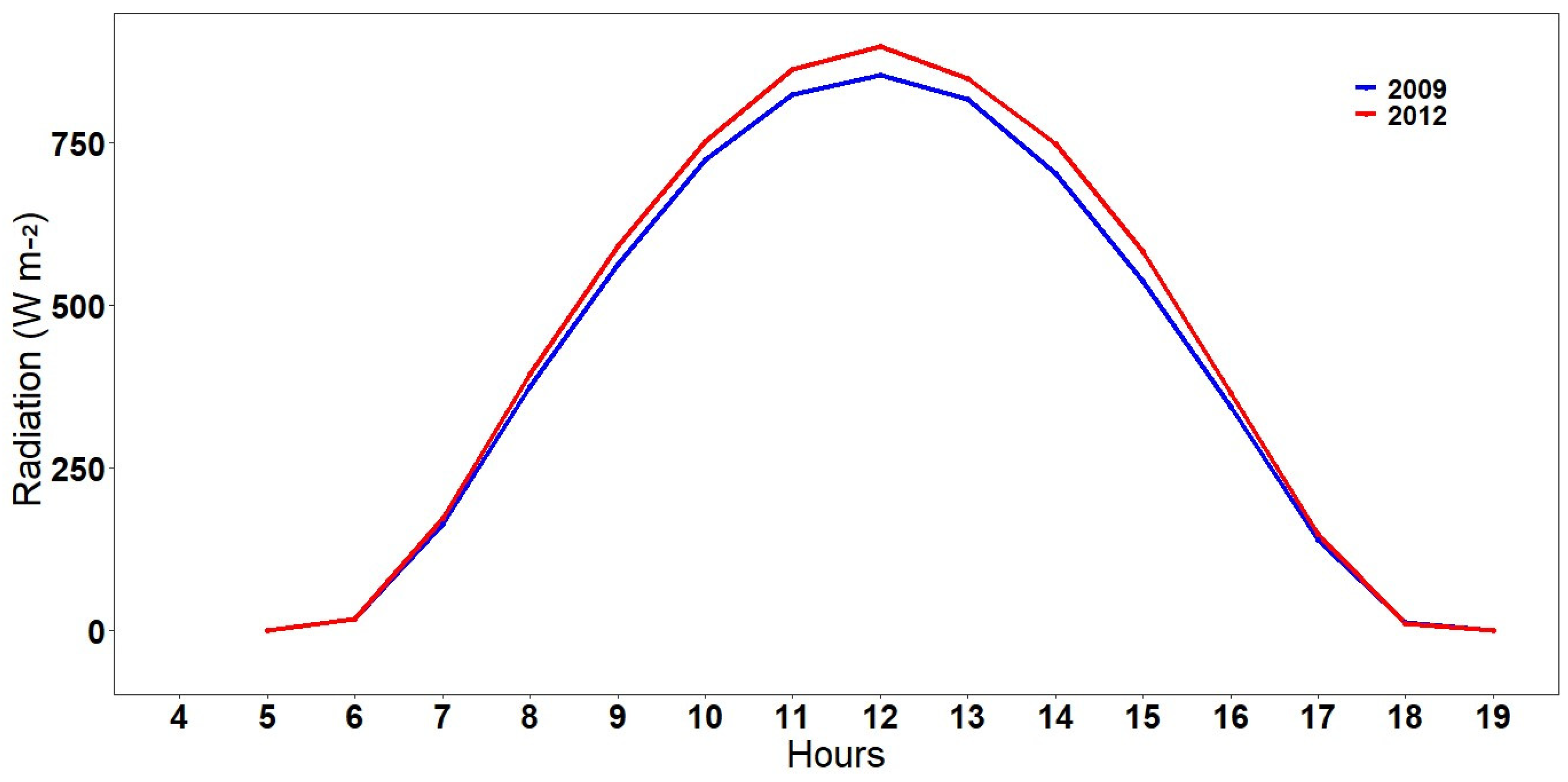
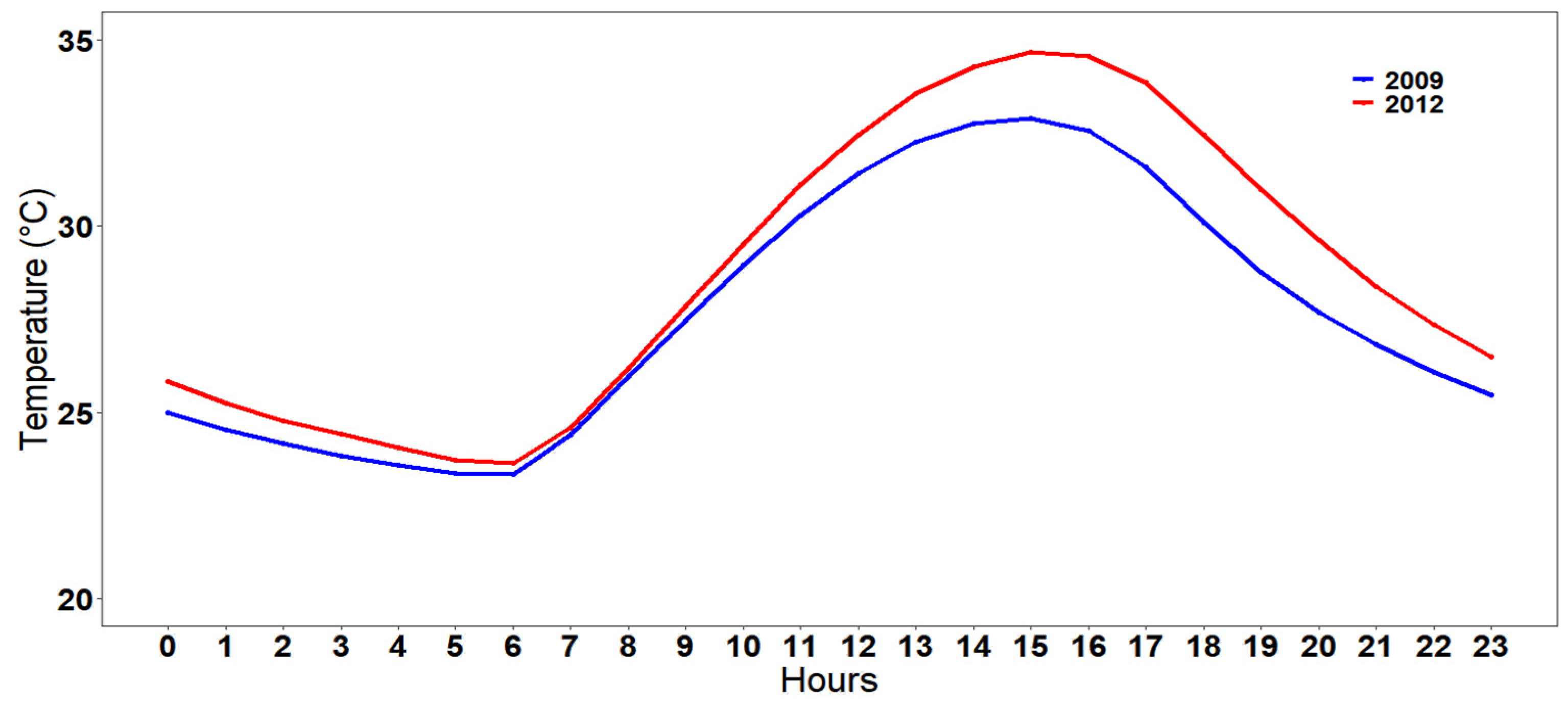
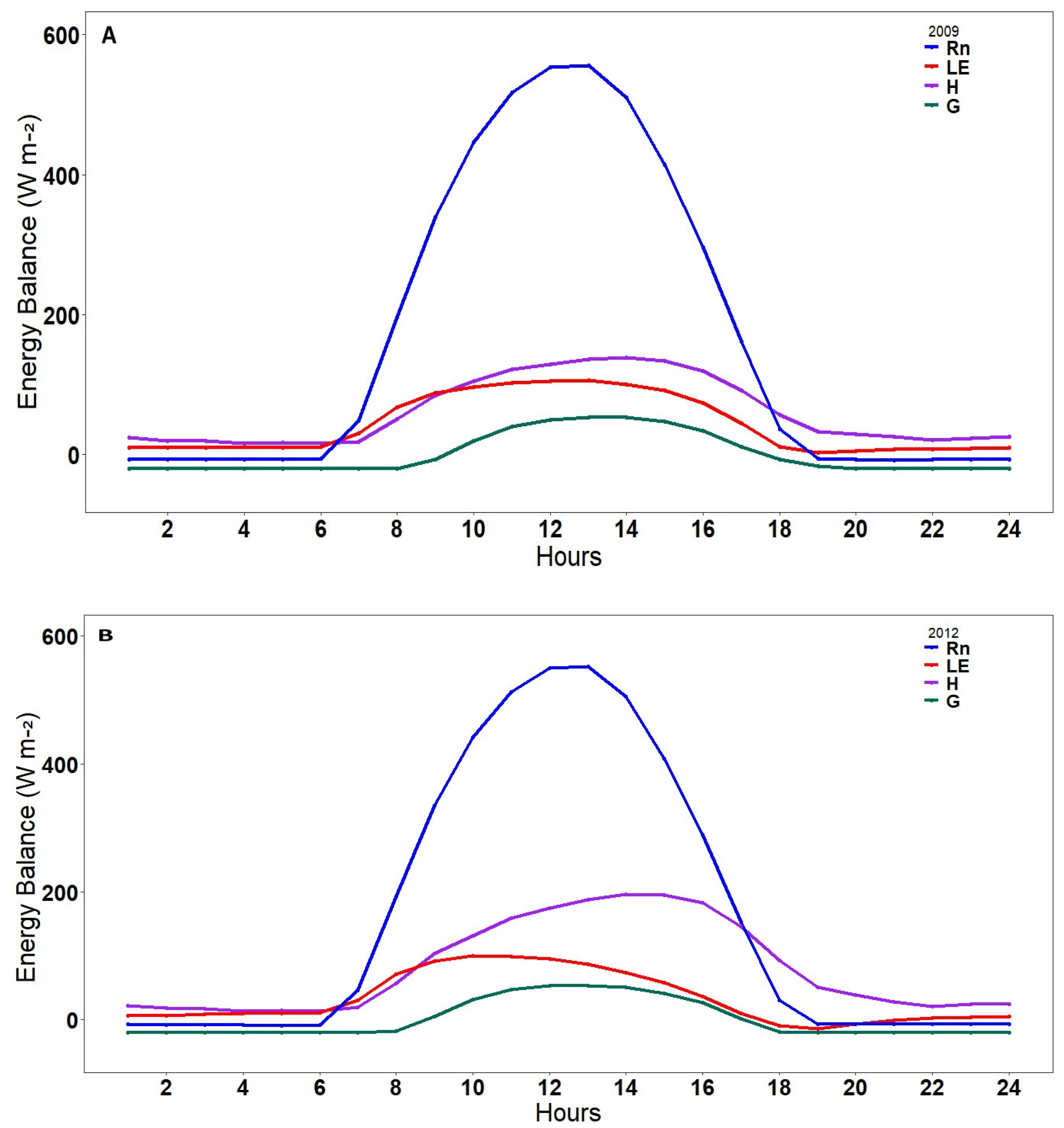
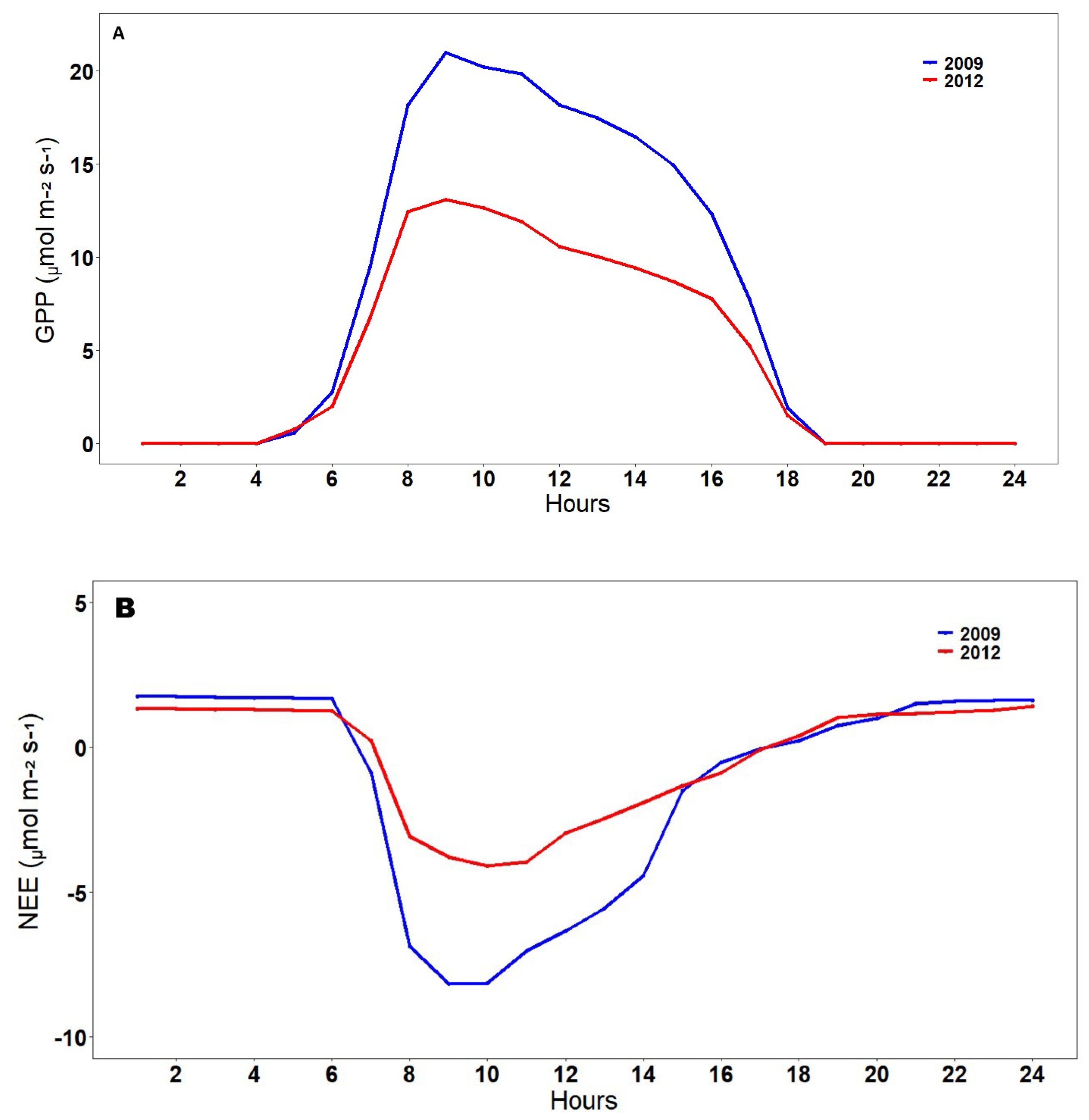
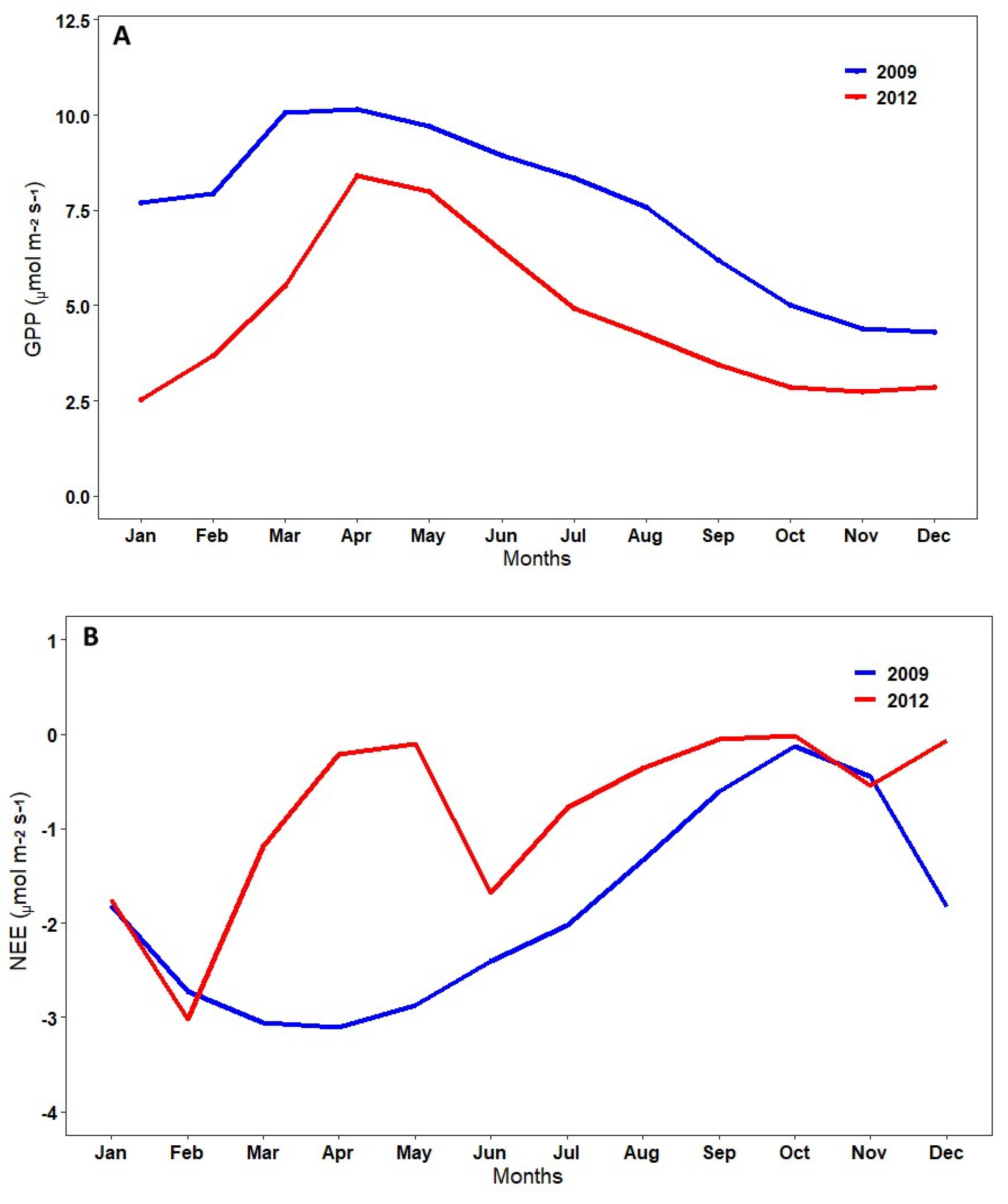

| Parameters | Wet Season | Dry Season | Source | |
|---|---|---|---|---|
| Initial | CO2 Flux Calibrated | |||
| Specific leaf area (sla) | 13.0 | 14.5 | 23.5 | [32,43] |
| typical dimension of leaves (du) | 0.072 | 0.056 | 0.032 | [32,44] |
| typical dimension of stems (ds) | 0.1 | 0.05 | 0.05 | [32,44] |
| Leaf width (w) | 0.1 | 0.06 | 0.03 | [32,44] |
| Stomatal conductance coefficient (m) | 10.0 | 8.0 | 4.0 | [17,32,43,45] |
| Maximum capacity of the Rubisco enzyme (Vmax) | 75 × 10−6 | 90 × 10−6 | 50 × 10−6 | [32,43,46] |
| Initial soil moisture fraction (θg/θd) | 0.36 | 0.225 | 0.105 | [32,36,47] |
| 2009 (Heavy Rainfall) | 2012 (Extreme Drought) | |||||
|---|---|---|---|---|---|---|
| Annual | Wet Season | Dry Season | Annual | Wet Season | Dry Season | |
| Rn (Wm−2) | 166.4 | 170.2 | 166.7 | 163.4 | 167.4 | 164.4 |
| LE (Wm−2) | 42.6 | 59.0 | 35.9 | 32.8 | 43.5 | 26.0 |
| H (Wm−2) | 60.6 | 41.8 | 88.8 | 80.4 | 53.8 | 115.6 |
| G (Wm−2) | 0.9 | 0.8 | 0.7 | 0.7 | 0.3 | 0.6 |
| R (Wm−2) | 62.3 | 68.6 | 41.3 | 49.5 | 69.8 | 22.2 |
| ED (Wm−2) | 165.6 | 169.4 | 166.0 | 162.7 | 167.1 | 163.8 |
| EBC | 0.62 | 0.60 | 0.75 | 0.70 | 0.58 | 0.86 |
| LE/Rn (%) | 25.6 | 34.0 | 21.5 | 20.0 | 26.0 | 16.0 |
| H/Rn (%) | 36.4 | 24.5 | 53.3 | 49.2 | 32.1 | 70.3 |
| G/Rn (%) | 0.5 | 0.48 | 0.4 | 0.4 | 0.2 | 0.3 |
| R/Rn (%) | 40 | 20 | 40 | 30 | 20 | 40 |
Disclaimer/Publisher’s Note: The statements, opinions and data contained in all publications are solely those of the individual author(s) and contributor(s) and not of MDPI and/or the editor(s). MDPI and/or the editor(s) disclaim responsibility for any injury to people or property resulting from any ideas, methods, instructions or products referred to in the content. |
© 2023 by the authors. Licensee MDPI, Basel, Switzerland. This article is an open access article distributed under the terms and conditions of the Creative Commons Attribution (CC BY) license (https://creativecommons.org/licenses/by/4.0/).
Share and Cite
Mendes, K.R.; Marques, A.M.S.; Mutti, P.R.; Oliveira, P.E.S.; Rodrigues, D.T.; Costa, G.B.; Ferreira, R.R.; Silva, A.C.N.d.; Morais, L.F.; Lima, J.R.S.; et al. Interannual Variability of Energy and CO2 Exchanges in a Remnant Area of the Caatinga Biome under Extreme Rainfall Conditions. Sustainability 2023, 15, 10085. https://doi.org/10.3390/su151310085
Mendes KR, Marques AMS, Mutti PR, Oliveira PES, Rodrigues DT, Costa GB, Ferreira RR, Silva ACNd, Morais LF, Lima JRS, et al. Interannual Variability of Energy and CO2 Exchanges in a Remnant Area of the Caatinga Biome under Extreme Rainfall Conditions. Sustainability. 2023; 15(13):10085. https://doi.org/10.3390/su151310085
Chicago/Turabian StyleMendes, Keila R., Ana M. S. Marques, Pedro R. Mutti, Pablo E. S. Oliveira, Daniele T. Rodrigues, Gabriel B. Costa, Rosaria R. Ferreira, Any C. N. da Silva, Leonardo F. Morais, José Romualdo S. Lima, and et al. 2023. "Interannual Variability of Energy and CO2 Exchanges in a Remnant Area of the Caatinga Biome under Extreme Rainfall Conditions" Sustainability 15, no. 13: 10085. https://doi.org/10.3390/su151310085
APA StyleMendes, K. R., Marques, A. M. S., Mutti, P. R., Oliveira, P. E. S., Rodrigues, D. T., Costa, G. B., Ferreira, R. R., Silva, A. C. N. d., Morais, L. F., Lima, J. R. S., Antonino, A. C. D., Menezes, R. S. C., Silva, C. M. S. e., & Bezerra, B. G. (2023). Interannual Variability of Energy and CO2 Exchanges in a Remnant Area of the Caatinga Biome under Extreme Rainfall Conditions. Sustainability, 15(13), 10085. https://doi.org/10.3390/su151310085









